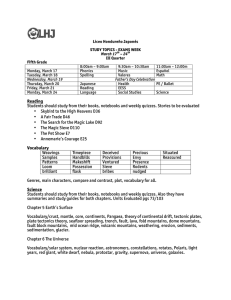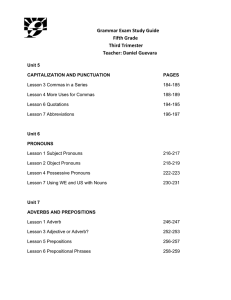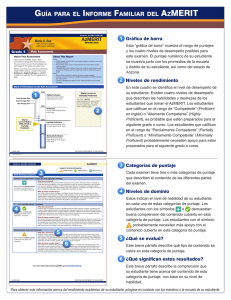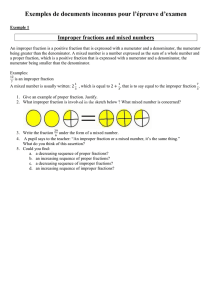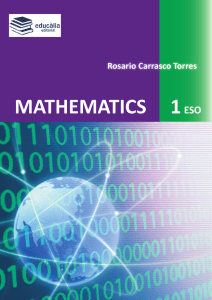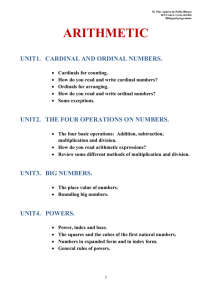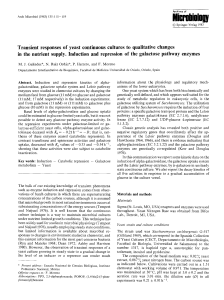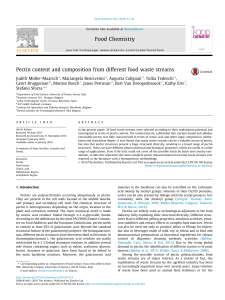Fucoidans from the brown seaweed Adenocystis utricularis: extraction methods, antiviral activity and structural studies
Anuncio
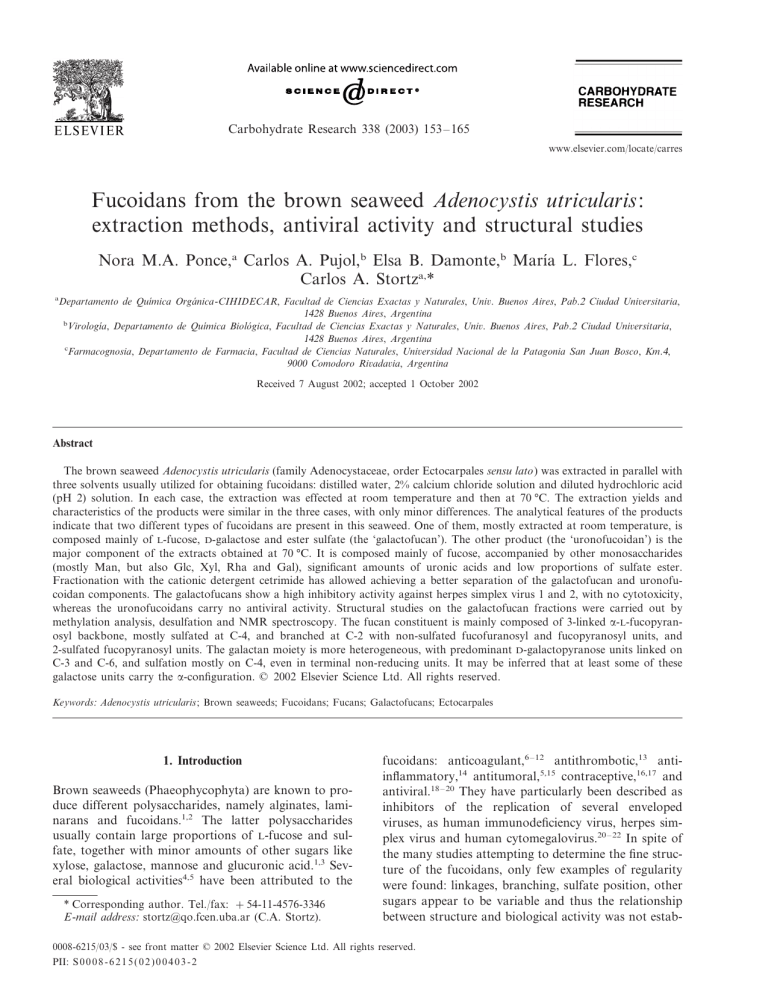
Carbohydrate Research 338 (2003) 153–165 www.elsevier.com/locate/carres Fucoidans from the brown seaweed Adenocystis utricularis: extraction methods, antiviral activity and structural studies Nora M.A. Ponce,a Carlos A. Pujol,b Elsa B. Damonte,b Marı́a L. Flores,c Carlos A. Stortza,* a Departamento de Quı́mica Orgánica-CIHIDECAR, Facultad de Ciencias Exactas y Naturales, Uni6. Buenos Aires, Pab.2 Ciudad Uni6ersitaria, 1428 Buenos Aires, Argentina b Virologı́a, Departamento de Quı́mica Biológica, Facultad de Ciencias Exactas y Naturales, Uni6. Buenos Aires, Pab.2 Ciudad Uni6ersitaria, 1428 Buenos Aires, Argentina c Farmacognosia, Departamento de Farmacia, Facultad de Ciencias Naturales, Uni6ersidad Nacional de la Patagonia San Juan Bosco, Km.4, 9000 Comodoro Ri6ada6ia, Argentina Received 7 August 2002; accepted 1 October 2002 Abstract The brown seaweed Adenocystis utricularis (family Adenocystaceae, order Ectocarpales sensu lato) was extracted in parallel with three solvents usually utilized for obtaining fucoidans: distilled water, 2% calcium chloride solution and diluted hydrochloric acid (pH 2) solution. In each case, the extraction was effected at room temperature and then at 70 °C. The extraction yields and characteristics of the products were similar in the three cases, with only minor differences. The analytical features of the products indicate that two different types of fucoidans are present in this seaweed. One of them, mostly extracted at room temperature, is composed mainly of L-fucose, D-galactose and ester sulfate (the ‘galactofucan’). The other product (the ‘uronofucoidan’) is the major component of the extracts obtained at 70 °C. It is composed mainly of fucose, accompanied by other monosaccharides (mostly Man, but also Glc, Xyl, Rha and Gal), significant amounts of uronic acids and low proportions of sulfate ester. Fractionation with the cationic detergent cetrimide has allowed achieving a better separation of the galactofucan and uronofucoidan components. The galactofucans show a high inhibitory activity against herpes simplex virus 1 and 2, with no cytotoxicity, whereas the uronofucoidans carry no antiviral activity. Structural studies on the galactofucan fractions were carried out by methylation analysis, desulfation and NMR spectroscopy. The fucan constituent is mainly composed of 3-linked a-L-fucopyranosyl backbone, mostly sulfated at C-4, and branched at C-2 with non-sulfated fucofuranosyl and fucopyranosyl units, and 2-sulfated fucopyranosyl units. The galactan moiety is more heterogeneous, with predominant D-galactopyranose units linked on C-3 and C-6, and sulfation mostly on C-4, even in terminal non-reducing units. It may be inferred that at least some of these galactose units carry the a-configuration. © 2002 Elsevier Science Ltd. All rights reserved. Keywords: Adenocystis utricularis; Brown seaweeds; Fucoidans; Fucans; Galactofucans; Ectocarpales 1. Introduction Brown seaweeds (Phaeophycophyta) are known to produce different polysaccharides, namely alginates, laminarans and fucoidans.1,2 The latter polysaccharides usually contain large proportions of L-fucose and sulfate, together with minor amounts of other sugars like xylose, galactose, mannose and glucuronic acid.1,3 Several biological activities4,5 have been attributed to the * Corresponding author. Tel./fax: +54-11-4576-3346 E-mail address: [email protected] (C.A. Stortz). fucoidans: anticoagulant,6 – 12 antithrombotic,13 antiinflammatory,14 antitumoral,5,15 contraceptive,16,17 and antiviral.18 – 20 They have particularly been described as inhibitors of the replication of several enveloped viruses, as human immunodeficiency virus, herpes simplex virus and human cytomegalovirus.20 – 22 In spite of the many studies attempting to determine the fine structure of the fucoidans, only few examples of regularity were found: linkages, branching, sulfate position, other sugars appear to be variable and thus the relationship between structure and biological activity was not estab- 0008-6215/03/$ - see front matter © 2002 Elsevier Science Ltd. All rights reserved. PII: S 0 0 0 8 - 6 2 1 5 ( 0 2 ) 0 0 4 0 3 - 2 N.M.A. Ponce et al. / Carbohydrate Research 338 (2003) 153–165 154 lished. Different techniques for extracting the fucoidans free from contaminants have been used.23,24 They included the action of calcium-containing solvents, acid media, or plain water.3,24 – 28 Adenocystis utricularis is a brown seaweed from the cold waters of the Southern Hemisphere. It is found close to the Antarctica, as well as on the coasts of Chile, Argentina, New Zealand and Australia.29 Its classification was revised many times, although it is now considered within the family Adenocystaceae,30 of the order Ectocarpales sensu lato.30,31 Herein the extraction of the polysaccharides from this seaweed by different methods is reported, together with their purification, analysis, fractionation, assessment of their antiviral activity, and structural analysis of the fractions with antiviral properties. 2. Experimental 2.1. Algal material The brown, globular seaweed Adenocystis utricularis was collected in summer at the shores near Comodoro Rivadavia (Chubut Province). The thalli were air-dried and milled to a fine powder. 2.2. Analytical methods Total carbohydrates were determined by the phenol– H2SO4 method using fucose as standard.32 Uronic acids were determined using the method of Filisetti-Cozzi and Carpita33 using glucuronolactone as standard. The percentages of sulfate were measured by turbidimetry34 after hydrolysis with 1 M HCl, while the soluble proteins were determined by the procedure of Lowry et al.35 Average molecular weights were estimated as described by Park and Johnson,36 and aminosugars by the colorimetric method of Smith and Gilkerson.37 Optical rotations of aqueous solutions of the samples (0.4%) were measured using a Perkin Elmer 343 polarimeter with the sodium D line of a Na lamp as light source. Hydrolysis of the polysaccharides was carried out with 2 M CF3COOH (90 min, 120 °C). Hydrolyzates were derivatized to the aldononitrile acetates38 and analyzed by GLC using a capillary column (30 m × 0.25 mm) coated with SP-2330 (0.20 mm) on a HP-5890 Gas Chromatograph equipped with a flame ionization detector (FID). Nitrogen was used as the carrier gas, with a flow rate of 1 mL/min and a split ratio of 100:1. Chromatography runs were isothermal at 220 °C, while the injector and detector were set at 235 °C. In order to detect the possible presence of cellulosic materials, the Morrison hydrolysis procedure39 with pure CF3COOH was carried out on a fraction. The identity of aminosugars was determined by GLC after nitrous acid deamination.38 Reduction of the uronic acid component of the extracts was carried out with the aid of the 1-(3-dimethylaminopropyl)-3-ethylcarbodiimide (EDC) and NaBH4, as described elsewhere.40 Determination of the configuration of the constituting monosaccharides was carried out as depicted by Cases et al.41 Methylated alditol acetates were analyzed using the same GLC system described above, but the oven temperature was programmed from 160 to 210 °C at 2 °C/ min, then from 210 to 240 °C at 5 °C/min. The GLC–MS analyses of the methylated alditol acetates was carried out on a Shimadzu QP 5050 A GC/MS apparatus working at 70 eV using similar conditions to those described above, but using He as gas carrier at a flow rate of 7 mL/min and a split ratio of 11:1. 2.3. Extraction The extraction procedures are summarized on Scheme 1. Shortly, the milled seaweed (500 g) was extracted with 80% aq EtOH (2.5 L) under mechanical stirring at room temperature and then at 70 °C (each for 24 h). The final residue was recovered by centrifugation and then split into three equal fractions (ca. 100 g) that were separately extracted with 800 mL of water, 2% CaCl2, and HCl (diluted to pH 2). Each extraction was carried out for 7 h at room temperature. The residues were centrifuged off and re-extracted exhaustively with the same solvents at 70 °C, up to the point where only small amounts of sugars were detected in the extract. The extracts were concentrated at reduced pressure, dialyzed (mol.wt cutoff 6,000–8,000 amu) and recovered by freeze-drying. 2.4. Fractionation A 10% (w/v) aq solution of hexadecyltrimethylammonium bromide (cetrimide, Sigma) was added slowly to a solution of each extract (500 mg) in water (100 mL) with stirring, until no further formation of complex occurred (usually after adding 6–8 mL). The mixture was kept stirring overnight, and then the precipitates were centrifuged off, suspended in 0.5 M NaCl (60 mL), and stirring was continued overnight. The precipitate was centrifuged off, and the supernatant was extracted with 1-pentanol (3× 30 mL), dialyzed, concentrated and freeze-dried ( −5 fractions). The remaining precipitate was submitted to similar consecutive procedures with NaCl concentrations increased to 1, 2, 3, and 4 M, yielding fractions with acronyms -10, -20, and -30, respectively (4 M NaCl only dissolved negligible amounts of product). N.M.A. Ponce et al. / Carbohydrate Research 338 (2003) 153–165 13 155 2.5. Desulfation 2.7. Desulfation of whole extracts and galactofucan fractions was attempted using solvolysis3,11 in dimethyl sulfoxide (alone, or in the presence of methanol or pyridine), and by the action of hydrochloric acid in methanol.42 Final desulfation was achieved by conversion into their pyridinium salts and treatment with chlorotrimethylsilane in anhydrous pyridine at 100° C for 8 h, twice, with intermediate recovery of the product, as described.43 The sample desulfated for NMR analysis was previously sonicated (see below). The spectra were obtained on a Bruker AM 500 spectrometer provided with a 5 mm probe, at room temperature. Solution of polysaccharide samples in H2O were sonicated at 20 kHz (3× 20 min), and then D2O was added to produce a solution containing ca. 40 mg in 0.4 mL of 1:1 H2O–D2O. Acetone was added as internal standard (referred to Me4Si by calibrating the acetone methyl group to 31.1 ppm). Typical parameters were as follows: maximum acquisition time, no relaxation delay, 90°-pulse angle, and 40,000 scans. 2.6. Methylation analysis 2.8. Antiviral assays The triethylammonium salts of selected fractions (5 mg) were methylated as described by Ciucanu and Kerek,44 using three stepwise additions of NaOH and CH3I, as it was found that fewer additions or other procedures originated undermethylation. The methylated fucans were hydrolyzed (2 M TFA, 90 min, 120° C), and the partially methylated monosaccharides were derivatized to the alditol acetates, which were then analyzed by GLC, and characterized by GLC – MS, as described above. Vero (African green monkey kidney) cells were grown in minimum essential medium (MEM) supplemented with 5% bovine serum. HSV-1 strain F and HSV-2 strain G were obtained from the American Type Culture Collection (Rockville, USA). Vero cell viability was measured by the MTT (3-(4,5dimethylthiazol-2-yl)-2,5-diphenyl tetrazolium bromide; Sigma–Aldrich) method.45 The CC50 (cytotoxic concentration 50%) was calculated as the compound concentration required to reduce cell viability by 50%. Scheme 1. C NMR spectroscopy N.M.A. Ponce et al. / Carbohydrate Research 338 (2003) 153–165 156 Table 1 Yields and analyses of the products extracted from Adenocystis utricularis by different procedures Carbohydrate a (% anh.) Fraction Yield (%) EO1 EO2 19.1 18.9 1 1 1 1 0 −1 EW1 EC1 EA1 2.4 4.2 2.1 42 51 59 10 2 2 −42 −55 −63 EW2 EC2 EA2 10.8 2.9 9.6 69 58 66 11 3 7 −103 −56 −97 a Protein (%) [a]D (°) Mol.wt. (kD) Uronic acid (%) Sulfate (% SO3Na) n.d. n.d. tr. tr. tr. tr. 8 8 8 30 34 32 30 10 26 8 24 12 15 18 19 6.5 16 11 0.2–0.3% of aminosugars were detected in the polysaccharidic extracts. Antiviral activity was evaluated by reduction of virus plaque formation. Vero cell monolayers grown in 24well plates were infected with about 50 plaque-forming units (PFU) of virus/well in the absence or presence of various concentrations of the compounds. Plaques were counted after 2 days of incubation at 37 °C. The inhibitory concentration 50% (IC50) was calculated as the compound concentration required to reduce virus plaque by 50%. All determinations were performed twice and each in duplicate. 3. Results 3.1. Extraction The milled seaweed was extracted as depicted in Scheme 1. Yields and general analyses of the extracts are shown on Table 1, while the monosaccharide composition is shown on Table 2. Treatment of the seaweed with 80% aqueous ethanol at room temperature and 70 °C removed large amounts of materials. Their analysis revealed small proportions of carbohydrates and proteins, while the monosaccharide composition indicated that mannitol was nearly the only carbohydrate present. Hydrolysis yielded traces of fucose and galactose (in EO2). Ash accounted for about 38% and 52% of the samples EO1 and EO2, respectively, indicating that salts and mannitol are their main components. In order to study the action of different extraction media, the residue obtained from the alcoholic extraction was reextracted in parallel with three different solvents: water, 2% calcium chloride, and diluted hydrochloric acid (pH 2). In each case, one extraction was enacted at room temperature, and then exhaustively at 70 °C. The three extraction procedures behave in a similar way: room temperature extraction led to lower yields (2.1– 4.2%) of products, highly sulfated (30– 34%), with low proportions of uronic acids (8%) and protein (2– 10%). The 70 °C extraction effected with calcium chloride also gave low yields of a product with similar analyses. The other two extraction procedures at higher temperatures led to higher yields (9.6 –10.8%) of products with lower amounts of sulfate (8–12%) and higher proportions of uronic acids (26–30%) and protein (7–11%). Fucose is the main monosaccharide in all the fractions (Table 2, 60–84%). Galactose appears in significant amounts (10–23%), while the proportions of mannose and glucose are only significant in the uronate-rich fractions extracted at higher temperatures (5–9%). Determination of the configuration of the main monosaccharides was carried out on EW1, showing that L-fucose and D-galactose are present. No major differences are observed among the extraction procedures. However, that effected in acid medium at room temperature is the richest in fucose content, while that achieved with the same agent at 70 °C is the poorest in fucose content. Colorimetric analysis indicated that 0.2–0.3% of the samples are constituted by aminosugars (Table 1), the identity of which was established as glucosamine. The antiviral activities of the eight extracted fractions are shown on Table 3. The hydroalcoholic extracts do not show inhibitory activity, while the room temperature extracts exhibit considerable activity against HSV1 and HSV-2, with IC50 values ranging from 1.25 to Table 2 Monosaccharide composition (mols/100 mols) of the products extracted from Adenocystis utricularis by different procedures Fraction Rha Fuc Xyl Man Glc Gal EW1 EC1 EA1 1 2 1 74 73 84 tr. 1 tr. 2 4 4 1 2 1 22 18 10 EW2 EC2 EA2 1 2 1 70 75 60 1 1 2 9 3 9 5 3 5 14 17 23 N.M.A. Ponce et al. / Carbohydrate Research 338 (2003) 153–165 157 Table 3 Antiviral and cytotoxic activities of the products extracted from Adenocystis utricularis by different procedures Fraction CC50 (mg/mL) IC50 (mg/mL) HSV-1 HSV-2 EO1 EO2 \100 \100 \100 \100 EW1 EC1 EA1 2.109 0.56 1.3290.10 1.2590.30 2.1690.27 2.0090.09 1.63 90.54 EW2 EC2 EA2 24.7391.46 2.9090.42 4.7990.44 32.489 6.47 2.4790.32 8.4692.20 2.16 mg/mL and no cytotoxicity (CC50 \1000 mg/mL). The fractions EW2 and EA2, which were extracted at higher temperatures, were less active, especially EW2 (Table 3). On the other hand, the fraction extracted at high temperature with calcium chloride (EC2), shows an antiviral activity similar to the fractions obtained at room temperature, in agreement to their similar chemical composition (Tables 1 and 2). 3.2. Fractionation Attempts of fractionation by anion-exchange chromatography, which proved useful in previous cases,15,46 was unsuccessful with this product. EW1 did not elute at all from a DEAE-Sephadex A-50 column. Mixtures of the gel with neutral Sephadex47 G-100 also failed to separate either EW1 or EC1, as most of the sample appeared in only one peak. Fractionation was finally carried out with the aid of cetrimide precipitation, which was performed on the six fractions. The insoluble salts were stepwise redissolved with the aid of increasing concentrations of sodium chloride: yields and analyses are shown on Table 4. As expected, only small amounts of products (-0) remained soluble in presence of the cationic detergent, but surprisingly they carried significant amounts of anionic groups like sulfate and uronate. Although fucose was an important constituent, considerable amounts of sugars like rhamnose, xylose, mannose, and especially glucose were encountered. The analysis of the fractions isolated by redissolution of the cetrimide precipitate indicates a direct relationship between the percentages of sulfate and the concentrations of NaCl necessary to solubilize the fractions. The percentages of uronic acid follow the opposite trend, as occurred in the originally extracted fractions. Although fucose is the main monosaccharide in all fractions, the monosaccharide compositions also show a straightforward behavior regarding the concentration of redissolution: the galac- SI HSV-1 HSV-2 inactive inactive inactive inactive \1000 \1000 \1000 \480 \760 \800 \460 \500 \600 \1000 1000 \1000 \40 345 \200 \30 405 \120 \200 \200 tose content increases with the NaCl concentration, while those of rhamnose, xylose and mannose decrease sharply. In the room temperature extracted samples, there are two main fractions with dissimilar characteristics: one redissolved at 0.5 M NaCl represents a fucoidan with low sulfate content, high proportions of uronic acids, intermediate molecular weight (12,000– 15,000) and significant heterogeneity of monosaccharides (Rha, Xyl, Man, Gal). The other, redissolved at 2 M NaCl is a heavily sulfated galactofucan (or galactan/ fucan mixture). The fractionation of the product extracted with calcium chloride at 70 °C gives rise to the same results, as expected considering its analysis. The fractionations of the other two products extracted at 70 °C also show a similar pattern. However, the main fraction becomes the mannose/uronate rich product. The fractions originated in EW2 and EA2 show decreased molecular weights (Table 4). The optical rotations of the -20 fractions have values between −69° and − 81°, typical of a-linked L-fucans. It was not possible to determine the nature of the uronic acid present in the -20 fractions, as they carried only small amounts, and the differences found in the monosaccharide compositions after carboxyl reduction are within the expected error. On the uronate-rich − 5 fractions, carboxyl reduction, hydrolysis, and formation of the acetylated aldononitriles showed a marked increase of acetylated mannononitrile and the appearance of acetylated gulononitrile and 1,6-anhydrogulose, the expected hydrolysis products of alginic acid.48 The antiviral activities of the main fractions are shown in Table 5. Those fractions redissolved at 2 M NaCl concentrate the higher activities, while the heterogeneous fractions redissolved at low ionic strengths exhibited no activity up to 100 mg/mL. A fraction redissolved in 1 M NaCl exhibited a lower activity with respect to that redissolved in 2 M NaCl, as expected. Within the latters, the fractions originated in room temperature-extracted products are those which give N.M.A. Ponce et al. / Carbohydrate Research 338 (2003) 153–165 158 rise to the highest activity (IC50 0.28 – 1.36 mg/mL, Table 5), while the fractions becoming from higher temperature extractions, showed a reduced activity, probably due to their lower molecular weights. 3.3. Desulfation Attempts to desulfate the whole extracts and galactofucan fractions using solvolysis in dimethyl sulfoxide (alone, or in the presence of methanol or pyridine) or by the action of hydrochloric acid in methanol were unsuccessful, as they removed no sulfate. The whole extract EW1 was successfully desulfated by the action of chlorotrimethylsilane in anhydrous pyridine. The first desulfation step removed about 50% of the sulfate present, whereas after the second step a desulfated product carrying ca. 30% of the original sulfate present was produced. The monosaccharide composition remained similar to the original, though slight increases in the mannose content have been found. The fractions EA1-20, EW1-20 and EA2-20 were also submitted to the two-step desulfation procedure, yielding fractions EA1-20D, EW1-20D and EA2-20D, with more than a 65% decrease in their sulfate content. 3.4. Methylation analysis The galactofucans from the fractions redissolved in 2 M Table 4 Analyses of the fractions obtained by cetrimide precipitation and redissolution of the products extracted from Adenocystis utricularis by different procedures Yield (%) Carbohyd. (% anh.) Uronate (%) Sulfate (% SO3Na) Mol.wt. (kD) Neutral sugars (mol/100 mols) Rha Fuc Xyl Man Glc Gal EW1-0 a EW1-5 EW1-10 EW1-20 EW1-30 2.4 12.1 5.1 25.8 8.2 33 59 58 59 56 8 24 9 6 4 18 8 17 24 24 n.d. 13 12 \100 \100 8 6 4 – – 44 54 70 80 74 11 4 2 – – 8 24 7 – – 23 5 – – – 6 7 17 20 26 EC1-0 EC1-5 EC1-10 EC1-20 EC1-30 5.0 6.0 5.0 27.9 2.9 56 63 62 66 52 9 22 10 6 3 21 12 22 22 28 6 15 25 \100 n.d. 9 5 4 – 1 33 57 69 82 70 9 4 2 – – 16 14 3 – 1 20 6 2 – 1 13 14 20 18 26 EA1-0 EA1-5 EA1-10 EA1-20 EA1-30 1.3 29.2 4.9 33.0 5.3 53 60 54 57 20 8 42 10 4 1 13 5 14 23 24 n.d. 12 18 \100 \100 6 8 6 1 1 31 47 66 83 62 6 4 2 – – 18 26 9 1 1 32 6 3 – 2 7 9 14 15 34 EW2-0 EW2-5 EW2-10 EW2-20 EW2-30 1.8 32.3 4.2 9.5 1.9 46 57 49 45 42 11 41 11 4 1 8 7 18 24 30 n.d. 6 5 7 n.d. 3 – 1 1 1 25 53 80 80 53 4 4 2 – 1 12 34 10 1 1 50 1 – – – 6 8 7 18 44 EC2-0 EC2-5 EC2-10 EC2-20 EC2-30 2.4 14.7 6.9 26.4 5.4 29 77 69 69 72 5 23 11 7 3 25 8 19 24 27 3 19 27 \100 \100 3 2 5 1 1 42 55 72 82 65 4 11 3 – – 10 20 5 – – 36 2 2 – – 5 10 13 17 34 EA2-0 EA2-5 EA2-10 EA2-20 EA2-30 3.1 37.1 4.4 13.9 3.0 56 59 67 76 50 16 31 12 6 2 23 6 19 21 29 3 8 11 33 44 4 3 2 1 1 29 58 65 75 58 4 3 3 1 1 16 29 8 1 1 42 1 2 1 1 5 6 20 21 38 a The acronym of the original fraction incorporates a number indicating the concentration of NaCl necessary to redissolve the fraction, in tenths of molarity (e.g., EA1-10 is the fraction of the EA1 product redissolved with 1 M NaCl). N.M.A. Ponce et al. / Carbohydrate Research 338 (2003) 153–165 159 Table 5 Antiviral and cytotoxic activities of some subfractions isolated from Adenocystis utricularis Fraction CC50 (mg/mL) IC50 (mg/mL) HSV-1 HSV-2 EW1-5 EC1-5 EA1-5 \100 \100 \100 \100 \100 \100 EW2-5 EC2-5 EA2-5 \100 \100 \100 EC1-10 SI HSV-1 HSV-2 n.d. \1000 n.d. inactive inactive inactive inactive inactive inactive \100 \100 \100 n.d. \1000 \1000 inactive inactive inactive inactive inactive inactive 10.090.2 15.9190.54 \1000 \100 \60 EW1-20 EC1-20 EA1-20 0.7190.01 0.8790.03 0.2890.01 1.3690.05 0.67 90.07 0.5290.01 \1000 \1000 \1000 \1400 \1150 \3600 \750 \1500 \1900 EW2-20 EC2-20 EA2-20 7.949 3.19 1.5690.08 2.9890.22 11.8490.92 1.259 0.20 2.9790.49 \1000 \1000 \1000 \125 \650 \335 \84 \800 \335 Table 6 Methylation analysis (mols/100 mols) of some fractions isolated from Adenocystis utricularis 2,3,4-Me3 Fuc 2,3,5-Me3 Fuc 2,3-Me2 Fuc 2,4-Me2 Fuc 3,4-Me2 Fuc 2-Me Fuc 3-Me Fuc 4-Me Fuc Fuc 2,3,4,6-Me3 Gal 2,3,4-Me3 Gal 2,3,6-Me3 Gal 2,4,6-Me3 Gal 2,3-Me2 Gal 2,4-Me2 Gal 2,6-Me2 Gal 3,4-Me2 Gal 3,6-Me2 Gal 2-Me Gal 3 or 4-Me Gal 6-Me Gal Gal a EW1-20 EC1-20 EA1-20 EW2-20 EC2-20 EA2-20 EA1-20D EA2-20D 3 4 2 8 9 16 1 22 12 tr. 1 7 3 4 3 9 9 14 1 24 13 tr. tr. 6 3 4 2 7 9 16 2 21 11 tr. 1 6 3 2 6 8 6 11 2 14 16 3 6 3 3 3 3 10 7 15 2 20 12 tr. 1 5 2 3 3 9 6 19 2 16 13 1 2 4 5 3 1 23 6 3 tr. 18 9 6 9 1 6 3 3 21 5 5 5 2 3 4 1 3 6 3 3 1 9 1 5 3 4 4 5 4 1 3 1 1 tr. 2 2 1 1 1 2 3 1 1 tr. 2 7 tr. tr. tr. 1 3 1 1 1 1 5 1 tr. tr. 3 1 1 2 tr. 1 1 1 5 15 2 8 13 1 8 4 1 2 1 tr. tr. 1 1 1 a Small amounts of mannose and glucose were detected non-methylated and 2,3,6-tri-O-methylated in all the fractions, whereas for the desulfated fractions, non-methylated and 2,3-di-O-methylated xylose was also detected. NaCl were submitted to a three-step methylation procedure (Table 6). They show the same pattern, although EW2-20 and EA2-20 present minor differences. A great heterogeneity of units is found. Minor amounts of methylated (indicating 4-linked units) and non-methyl- ated mannose and glucose were found, in spite of the trace amounts of these sugars present in the original polysaccharide. However, when a strong hydrolysis was carried out on EC1-20 (to detect fibrillar material), the amounts of mannose and glucose remained unaltered. N.M.A. Ponce et al. / Carbohydrate Research 338 (2003) 153–165 160 Desulfated fractions EA1-20D and EA2-20D were also methylated (Table 6). Besides the reported glucose and mannose derivatives, in the analysis of desulfated products, minor amounts of xylose units methylated (indicating 4-linked units)26 and non-methylated were found. The results agree with the expected effect of desulfation, i.e., the degree of methylation has increased. However, the percentage of galactose derivatives has also increased (as also occurs for original fraction EW2-20), and for fraction EA1-20D signs of slight undermethylation are present. In all the fractions some terminal, fucofuranosyl units are also found. 3.5. 13 C NMR spectroscopy The 13C NMR spectra of EW1-20, EC1-20 and EA1-20 are shown in Fig. 1. The three spectra are very similar: three main anomeric signals appear, at 100.6, 99.6 and 98.3 ppm, together with minor ones at 103.3, 101.2, 98.7, 94.6 and 93.7 ppm. A large signal for C-6 of fucose appears at 16.7 ppm, together with two smaller downfield signals. C-6 of an unsubstituted galactose appears sharply at 62.1 ppm. These results indicate that the L-fucose units are a-linked, as b-L-fucopyranosyl units should give rise to anomeric signals around 105 ppm. It is difficult to ascertain the anomeric configuration of the D-galactose units (see Discussion). A small signal around 177 ppm appears, originated in the scarce amounts of uronic acid present in the samples. No signals corresponding to O-acetyl groups were found.26 The spectrum of the desulfated product EW1-20D is also shown on Fig. 1. Several shifts are observed, indicating a considerable effect of the disappearance of sulfate on the spectrum pattern. 4. Discussion Several different procedures have been used for the extraction of fucoidans.24,26 – 28 The main concern in their isolation procedures was to avoid contamination with other polysaccharides, like laminaran and especially alginic acid.49 First extraction attempts were carried out by the use of plain water, often acidified, or other solvents.49 The first attempt to carry out a systematic approach to extraction was effected by Mian and Percival.24 They developed a sequential extraction that started by a formaldehyde treatment, followed by an 80% ethanol extraction, in order to remove mannitol, salts, and other low-molecular weight products. A further extraction with 2% calcium chloride (at room temperature and 70 °C) was used to extract fucoidans and laminaran (fixing the alginate as its calcium salt). Fucoidans were further extracted with aqueous hydrochloric acid (pH 2). At this point, the residue was extracted with sodium carbonate in order to render the alginate soluble. Two final additional solvents extracted further fucoidan fractions. This complicated sequential procedure was rarely followed completely afterwards, but became the basis of further work.26,28 Other authors used simpler extraction procedures, but applied elaborate purification steps.3,27 In this work, the brown seaweed Adenocystis utricularis was treated with ethanol, in order to remove mannitol, as described by Mian and Percival,24 and the residue was split into three portions, which were extracted with three solvents commonly used for brown seaweeds. The three extractions effected at room temperature (EW1, EC1 and EA1) gave very similar products of which D-galactose, L-fucose and sulfate ester are their main constituents, with minor amounts of other sugar components and uronic acids (Tables 1 and 2). It is worth noting the virtual absence of xylose, a monosaccharide usually found in nonpurified fucoidan extracts, and even in purified fractions.3,19,26,28 The yield of the water and acid-extracted products was alike, although calcium-aided extraction duplicated the yield (Table 1) of a product with similar analysis. Some subtle differences were found: (a) the extraction with a ionic solvent gives products almost devoid of protein, whereas the water extract is richer in this ‘contaminant’, and (b) the fucose/galactose ratio in the acid extract (EA1) doubles that present in the other extracts. The extractions effected at 70 °C gave higher yields of products with similar features. The larger yield of products effected by CaCl2 at room temperature brought about a much lower yield at 70 °C (Table 1) of a product (EC2) with a similar analysis to those of the room-temperature extracts. The other two products extracted at 70 °C show higher amounts of uronic acids and mannose, and low proportions of sulfate. Again, the water extraction removed more protein. The extraction with acid yielded a product with higher galactose content, thus reversing the trend shown at room temperature. This fact suggests that the difference does not originate with the destruction of galactose chains in EA1, but to differential extraction of products with diverse galactose/fucose ratios. The acid extraction does not produce appreciable cleavage as no major differences in yields and molecular weights were found. The molecular weights of the six products (6,500–19,000) are similar to those encountered in some other brown seaweed fucoidans,7,15,27 although in many cases products with values higher than 100,000 were found.18,23,27,50 It has been previously shown the presence of at least two different polysaccharides in fucoidan preparations of Sargassum stenophylum 3 and Fucus 6esiculosus.50 One contains usually just fucose, galactose and sulfate. Due to the predominance of fucose we have used the name ‘galactofucans’ for these products. The other ones (the ‘uronofucoidans’) have other monosaccharides (usually mannose and xylose), high amounts of uronic acids and fewer sulfate groups. N.M.A. Ponce et al. / Carbohydrate Research 338 (2003) 153–165 161 Fig. 1. 13C NMR spectra (125 MHz) of sonicated fractions EW1-20 (a), EC1-20 (b), EA1-20 (c) and sonicated-desulfated fraction EW1-20D (d) in the 10 –110 ppm region. Spurious peaks (mostly from cetrimide) are marked with an asterisk. The peak at 31.1 ppm corresponds to the internal standard (acetone). 162 N.M.A. Ponce et al. / Carbohydrate Research 338 (2003) 153–165 Even before fractionation and purification, the extracts from A. utricularis effected at room temperature (as well as EC2) are enriched in the galactofucan component, while the other two extracted at higher temperatures are enriched in the uronofucoidan component. Cetrimide precipitation and further fractionation by redissolution of the six extracts confirm the previously mentioned results. In most of the cases, two major fractions were obtained (Table 4): one redissolved with 0.5 M NaCl (-5 fractions), and the other redissolved with 2 M NaCl (-20 fractions). The former fractions have the analytical features of the uronofucoidan component: substantial amounts of mannose and uronic acid accompanying the fucose, with minor quantities of rhamnose, xylose, galactose and sulfate ester, and fairly low molecular weights (6,000 – 19,000). It is worthy of note that the main uronic acid components of these fractions are the usual components of alginic acid. Whether this originated with the co-extraction of isolated molecules of this polysaccharide27 or with the presence of alginate blocks in fucose-containing molecules will be the subject of further studies. The first hypothesis is supported by the meager extraction of these products effected by calcium containing solvents (Table 4). The fractions redissolved at 2 M NaCl concentration are typical galactofucans: they are almost devoid of monosaccharides different from fucose and galactose, carry high amounts of sulfate, and in most cases they have molecular weights higher than 100,000. Surprisingly, the fractions produced from the 70 °C hydrochloric acid extract carry higher molecular weights than those produced from distilled water at the same temperature. Separate fractions (2 – 8% yield) with galactofucan features were obtained by redissolving at higher NaCl concentrations (-30). They carry even larger amounts of sulfate and lower uronate content, and a lower fucose/galactose ratio. The fractions redissolved at 1 M sodium chloride (-10, 4– 7%) concentration show an intermediate behavior between the two main ones; they are probably a mixture of both kinds of polysaccharides, although the presence of both structures interspersed in the same molecules cannot be discarded. At last, fractions not precipitated by cetrimide were isolated. As expected, they are rich in glucose (probably for the presence of laminarans). However, they have ionic groups like sulfate and uronic acid, and usual monosaccharide components like fucose. It is possible that another interaction of the sulfate groups (probably through calcium bridges) precludes the interaction of these anionic groups with the cationic detergent. The galactofucan components of the fucoidan extracts from A. utricularis carry a high inhibitory activity against herpes simplex virus, with no cytotoxic activity (Tables 3 and 5). The whole extracts from the room temperature extractions had a marked activity, which appears diminished in the extractions effected at higher temperatures, as expected considering their lower proportion of galactofucan. Furthermore, an increased activity is encountered in the purified galactofucan fractions from the room temperature extractions. A similar activity was found for the hot calcium extracted fraction EC2-20, which has characteristics similar to those of the room temperature-extracts. The inhibitory activities of the other two -20 fractions obtained from 70 °C extractions (which have a lower molecular weight) are much lower. On the other hand, the uronofucoidan fractions have no activity at all up to a concentration of 100 mg/mL (Table 5). Previous work have already shown that biological activities are concentrated in those galactofucan fractions,3,15,50 as both large proportions of sulfate and high molecular weights are usually required for their action.6,8,11,18,51 Given the high antiviral activity of the galactofucan components of the fucoidans from A. utricularis, these fractions were chosen for structural analysis. Structural analysis of fucoidans has been usually difficult: methylation analysis, a usual procedure in structural determination is complicated by the steric hindrance provided by the sulfate to the methylation reagents,10 and the complex methylation patterns obtained.3 NMR spectra of fucoidans are also usually very complex,10 given the different environment of the fucose moieties with different linkages, sulfation and branching patterns, the presence of other monosaccharides, producing many signals that are hard to distinguish from the noise. A literature survey of different fucose-containing polysaccharides from brown seaweeds (fucoidans and variants like sargassans, ascophyllans, etc.) shows that the three available positions of fucose on C-2, C-3 and C-4 have appeared as points of linkage, branching and sulfate ester attachment. Attempts to find a regular structure modulated by small differences, as occurs in red seaweed galactans,52 were unsuccessful. The first models for the fucan moiety of fucoidans (mainly from F. 6esiculosus) indicated a 2-linked backbone1 with sulfate groups mostly on C-4, and minor degrees of branching. A similar structure was deduced for the antiviral fucoidan from Pel6etia fastigiata.18 However, further work revised the structure of the fucoidan from F. 6esiculosus,4 concluding that it actually carries a (13)-linked a-L-fucose backbone, with sulfate groups mainly at C-4 and branches at C-2. A similar structure was found in Laminaria saccharina.53 Sometimes slight modifications to this structure were found: a more complex branching scheme and galactose interspersed in Ecklonia kurome,6,7 high degree of branching and C-2 acetylation in Chorda filum,26 uronic acid substitution in Cladosiphon okamuranus,54 and main C-2 sulfation in a fraction from Ascophyllum nodosum.28 Even for fucans that originated in echinoderms a similar N.M.A. Ponce et al. / Carbohydrate Research 338 (2003) 153–165 structure was postulated.55 On the other hand, that structural scheme does not fit the other fucoidan fractions from A. nodosum, which show 3- and 4-linked fucose units, with most of the latter being disulfated.11,12,56 The galactose and fucose domains of the galactofucan should be analyzed separately, as there is evidence that they form separate blocks.57 The presence of short galactan chains and longer fucan chains7 has led to the suggestion of a small galactan core substituted by hairy branches of fucan domains.3 If this structure is confirmed, the polymer should be called ‘fucogalactan’. However, Nishino et al. encountered interspersed galactose and fucose moieties in oligosaccharides from E. kurome.6,7 Methylation analysis of the galactofucan of A. utricularis showed that the fucose appeared mainly nonmethylated and methylated in O-2 and O-4. Significant amount of 2,4- and 3,4-di-O-methylfucose were also found, together with minor quantities of terminal 2,3,4and 2,3,5-tri-O-methylfucose, 2,3-di-, and 3-O-methylfucose. After desulfation (one of the fractions exhibited undermethylation), the amount of 2,4-di-O-methylfucose increased mostly at expenses of 2-O-methyl- and non-methylated fucose. Minor increases of 2,3,4-tri-Omethylfucose were also produced, while the proportion of 4-O-methylfucose remained mostly unaltered. These data suggests the presence of a complex scheme, in which predominance of 3-linked fucopyranosyl units appear either sulfated on C-4, branched on C-2, or both together. This structure agrees with many of those presented lately.4,6,53 The increase in 2,3,4-tri-O-methylfucose after desulfation indicates the presence of sulfated terminal units (probably at C-4). On the other hand, the appearance of 2,3,5-tri-O-methylfucose indicates the presence of terminal fucofuranosyl units. As no other furanosic derivatives were found, these units should be devoid of sulfate ester. The presence of terminal fucofuranosyl units in several fucans has already been reported,4,6,7 but it was not detected in many fucoidans from other species.3,26,28,53 A very large dispersion of galactose units has been found, as occurred in the galactofucan from S. stenophyllum.3 The most important products of methylation are 2,3,6-tri- and 2,3-di-O-methylgalactose, followed by 2,4-, 2,6-, 3,6-di- and 2-mono-O-methylgalactose. After desulfation, the proportions of 2,3,4,6tetra-, 2,3,4-tri and 2,4,6-tri-O-methylgalactose (the latter in only one sample) appear increased at the expense of 2,3,6-tri-, 2,6-di- and 2-mono O-methylgalactose. These results indicate the presence of galactopyranosyl units linked mostly 13 and 1 6, with sulfate groups on C-4, even in non-reducing terminals. These linkages are amongst the most important found in a b-D-galactan isolated from Laminaria angustata,57 together with branching on C-4. In E. kurome, galactose linkages to 163 C-2 and C-3 were found,7 whereas in S. stenophyllum a complex structure, mainly 6-linked, with the fucan chains branched mostly on C-3, and sulfate groups on C-2 and C-3 were postulated.3 It should be mentioned that the galactose present in the galactofucan from A. utricularis belongs to the D series. Most of previous reports agree with this result, but Medcalf et al. found L-galactose as the constituent of the galactofucan from A. nodosum.58 Reported 13C NMR spectra of fucoidans carry contradictory data: for a 3-linked non-sulfated unit, most of the papers indicate that the anomeric signal should appear around 96–97 ppm (normalizing for different referencing systems).6,26,53,59 On the other hand, Marais and Joseleau28 ascribe a chemical shift of 99.6 –102.2 ppm to the same unit. Our data for the desulfated polymer (anomeric signals appear at 100.0 –102.5 ppm), with a structure carrying predominantly 3-linked a-Lfucopyranosyl units agree with the last assignment. Whether this is due to a missassignment or to more subtle structural details (the presence of galactose units around, the counterion) cannot be explained. Most of the anomeric signals of the native galactofucans from A. utricularis correspond to a-linked compounds. Only a small signal around 103.3 ppm can be ascribed to b-D-galactopyranosyl residues,3 but does not seem to include all the galactose present in those fractions, thus raising the question of the anomeric configuration of the D-galactose: the signal at 62.1 ppm shows that significant amounts of non-6-linked galactose are present in those fractions, whereas the signal at 86.0 ppm (not usually seen in similar products) could be ascribed to the C-3 of 3-linked galactose units.6 Consequently, it is possible that some of the peaks at 98–101 ppm correspond to a-D-galactopyranosyl moieties. Such units could have been neglected in other papers due to their overlapping with fucose signals. A signal at 81.5 ppm corresponds to the C-4 of sulfated a-Lfucopyranosyl units, as it almost disappears for the desulfated product. It is not easy to assign the signals corresponding to the main anomeric peaks; they could originate in 3-linked 4-sulfated, 3-linked 2-substituted and non-reducing terminal fucopyranosyl units and/or arise due to the presence of a-D-galactopyranosyl units. Structural details of the fucan moieties of the galactofucans of A. utricularis show its similarity with the fucoidans from L. saccharina.53 However, these studies do not allow one to determine many important aspects of their structure. For example, is there an attachment between the galactan and the fucan moieties, if they exist? Or, on the other hand is there an interspersion of both moieties6,7 or even the presence of separate polymers?57 It is expected that future work on this subject will throw light on the complex features of the fucoidans from brown seaweeds. 164 N.M.A. Ponce et al. / Carbohydrate Research 338 (2003) 153–165 Acknowledgements N.M.A.P. was recipient of a fellowship from FOMEC-UBA. E.B.D. and C.A.S. are Research Members of the National Research Council of Argentina (CONICET). M.L.F. is member of RIPRONAMED (Iberoamerican Network on Medicinal Natural Products), Sub-Program X (Pharmaceutical Fine Chemistry) of CYTED. This work was supported by grants from UBA, CONICET, and UNPSJB. References 1. Percival, E.; McDowell, R. H. Chemistry and Enzymology of Marine Algal Polysaccharides; Academic Press: New York, 1967; pp 157 –175. 2. Painter, T. J. Algal polysaccharides. In The Polysaccharides; Aspinall, G. O., Ed.; Academic Press: London, 1983; Vol. 2, pp 195 –285. 3. Duarte, M. E. R.; Cardoso, M. A.; Noseda, M. D.; Cerezo, A. S. Carbohydr. Res. 2001, 333, 281– 293. 4. Patankar, M. S.; Oehninger, S.; Barnett, T.; Williams, R. L.; Clark, G. F. J. Biol. Chem. 1993, 268, 21770–21776. 5. Renn, D. W. Medical and biotechnological applications of marine macroalgal polysaccharides. In Marine Biotechnology; Attaway, D. H.; Zaborsky, O. R., Eds.; Plenum Press: New York, 1993; Vol. 1, pp 181–196. 6. Nishino, T.; Nagumo, T.; Kiyohara, H.; Yamada, H. Carbohydr. Res. 1991, 211, 77–90. 7. Nishino, T.; Kiyohara, H.; Yamada, H.; Nagumo, T. Phytochemistry 1991, 30, 535– 539. 8. Nishino, T.; Nagumo, T. Carbohydr. Res. 1992, 229, 355– 362. 9. Nardella, A.; Chaubet, F.; Boisson-Vidal, C.; Blondin, C.; Durand, P.; Jozefonvicz, J. Carbohydr. Res. 1996, 289, 201 –208. 10. Pereira, M. S.; Mulloy, B.; Mourão, P. A. S. J. Biol. Chem. 1999, 274, 7656–7667. 11. Chevolot, L.; Foucault, A.; Chaubet, F.; Kervarec, N.; Sinquin, C.; Fisher, A.-M.; Boisson-Vidal, C. Carbohydr. Res. 1999, 319, 154–165. 12. Chevolot, L.; Mulloy, B.; Ratiskol, J.; Foucault, A.; Colliec-Jouault, S. Carbohydr. Res. 2001, 330, 529–535. 13. Mauray, S.; Sternberg, C.; Theveniaux, J.; Millet, J.; Sinquin, C.; Tapon-Bretaudiere, J.; Fischer, A. M. Thromb. Haemost. 1995, 74, 1280–1285. 14. Blondin, C.; Fischer, E.; Boisson-Vidal, C.; Kazatchkine, M.; Jozefonvicz, J. Mol. Inmunol. 1994, 31, 245–253. 15. Zhuang, C.; Itoh, H.; Mizuno, T.; Ito, H. Biosci. Bitech. Biochem. 1995, 59, 563–567. 16. Mahony, M. C.; Oehninger, S.; Clark, G. F.; Acosta, A. A.; Hodgen, G. D. Contraception 1991, 44, 657– 665. 17. Mahony, M. C.; Clark, G. F.; Oehninger, S.; Acosta, A. A.; Hodgen, G. D. Contraception 1993, 48, 277– 289. 18. Venkateswaran, P. S.; Millman, I.; Blumberg, B. S. Planta Med. 1989, 55, 265–270. 19. Feldman, S. C.; Reynaldi, S.; Stortz, C. A.; Cerezo, A. S.; Damonte, E. B. Phytomedicine 1999, 6, 335– 340. 20. McClure, M. O.; Whitby, D.; Patience, C.; Gooderham, N. J.; Bradshaw, A.; Cheingsong-Popov, R.; Weber, J. N.; Davies, D. S.; Cook, G. M.; Keynes, R. J.; Weiss, R. A. Anti6iral Chem. Chemother. 1991, 2, 149– 156. 21. Baba, M.; Snoeck, R.; Pauwels, R.; De Clercq, E. Antimicrob. Agents Chemother. 1988, 32, 1742–1745. 22. Beress, A.; Wassermann, O.; Bruhn, T.; Beress, L.; Kraiselburd, E. N.; González, L. V.; De Motta, G. E.; Chávez, P. I. J. Nat. Prod. 1993, 56, 478–488. 23. Bernardi, G.; Springer, G. F. J. Biol. Chem. 1962, 237, 75– 80. 24. Mian, A. J.; Percival, E. Carbohydr. Res. 1973, 26, 133 – 146. 25. Percival, E.; Venegas Jara, M. F.; Weigel, H. Carbohydr. Res. 1984, 125, 283–290. 26. Chizhov, A. O.; Dell, A.; Morris, H. R.; Haslam, S. M.; McDowell, R. A.; Shashkov, A. S.; Nifant’ev, N. E.; Khatuntseva, E. A.; Usov, A. I. Carbohydr. Res. 1999, 320, 108–119. 27. Zvyagintseva, T. N.; Shevchenko, N. M.; Popivnich, I. B.; Isakov, V. V.; Scobun, A. S.; Sundukova, E. V.; Elyakova, L. A. Carbohydr. Res. 1999, 322, 32–39. 28. Marais, M.-F.; Joseleau, J.-P. Carbohydr. Res. 2001, 336, 155–159. 29. Hoffmann, A.; Santelices, B. Marine Flora of Central Chile, Ediciones Universidad Católica de Chile: Santiago, 1997. 30. Rousseau, F.; De Reviers, B.; Leclerc, M.-C.; Asensi, A.; Delépine, R. Eur. J. Phycol. 2000, 35, 35 –43. 31. Peters, A. F.; Clayton, M. N. Phycologia 1998, 37, 106– 113. 32. Dubois, M.; Gilles, K. A.; Hamilton, J. K.; Rebers, P. A.; Smith, F. Anal. Chem. 1956, 28, 350 –356. 33. Filisetti-Cozzi, T. M. C. C.; Carpita, N. C. Anal. Biochem. 1991, 197, 157–162. 34. Dodgson, K. S.; Price, R. G. Biochem. J. 1962, 84, 106–110. 35. Lowry, O. H.; Rosebrough, N. J.; Farr, A. L.; Randall, R. J. J. Biol. Chem. 1951, 193, 265–275. 36. Park, J. T.; Johnson, M. J. J. Biol. Chem. 1949, 181, 149–151. 37. Smith, R. L.; Gilkerson, E. Anal. Biochem. 1979, 98, 478–480. 38. Turner, S. H.; Cherniak, R. Carbohydr. Res. 1981, 95, 137–144. 39. Morrison, I. M. Phytochemistry 1988, 27, 1097–1100. 40. Taylor, R. L.; Conrad, H. E. Biochemistry 1972, 11, 1383–1388. 41. Cases, M. R.; Cerezo, A. S.; Stortz, C. A. Carbohydr. Res. 1995, 269, 333–341. 42. Cases, M. R.; Stortz, C. A.; Cerezo, A. S. Int. J. Biol. Macromol. 1994, 16, 93 –97. 43. Kolender, A. A.; Matulewicz, M. C. Carbohydr. Res. 2002, 337, 57 –68. 44. Ciucanu, I.; Kerek, F. Carbohydr. Res. 1984, 131, 209 – 217. 45. Denizot, F.; Lang, R. J. Immunol. Methods 1986, 89, 271–277. 46. Matsuhiro, B.; Zúñiga, E.; Jashes, M.; Guaucucano, M. Hydrobiologia 1996, 321, 77 –81. 47. Stortz, C. A.; Cases, M. R.; Cerezo, A. S. Carbohydr. Polym. 1997, 34, 61 –65. 48. Usov, A. I.; Bilan, M. I.; Klochkova, N. G. Bot. Mar. 1995, 38, 43 –51. 49. Percival, E. Carbohydr. Res. 1968, 7, 272–283. 50. Nishino, T.; Nishioka, C.; Ura, H.; Nagumo, T. Carbohydr. Res. 1994, 255, 213– 224. 51. Nishino, T.; Nagumo, T. Carbohydr. Res. 1991, 214, 193–197. 52. Stortz, C. A.; Cerezo, A. S. Curr. Top. Phytochem. 2000, 4, 121–134. N.M.A. Ponce et al. / Carbohydrate Research 338 (2003) 153–165 53. Usov, A. I.; Smirnova, G. P.; Bilan, M. I.; Shashkov, A. S. Russ. J. Bioorg. Chem. 1998, 24, 437– 445. 54. Nagaoka, M.; Shibata, H.; Kimura-Takagi, I.; Hashimoto, S.; Kimura, K.; Makino, T.; Aiyama, R.; Ueyama, S.; Yokokura, T. Glycoconjugate J. 1999, 16, 19– 26. 55. Mulloy, B.; Ribeiro, A. C.; Alves, A. P.; Vieira, R. P.; Mourão, P. A. S. J. Biol. Chem. 1994, 269, 22113– 22123. 165 56. Daniel, R.; Berteau, O.; Jozenfovicz, J.; Goasdoue, N. Carbohydr. Res. 1999, 322, 291–297. 57. Nishino, T.; Takabe, Y.; Nagumo, T. Carbohydr. Polym. 1994, 23, 165–173. 58. Medcalf, D. G.; Schneider, T. L.; Barnett, R. W. Carbohydr. Res. 1978, 66, 167 –171. 59. Ribeiro, A. C.; Vieira, R. P.; Mourão, P. A. S.; Mulloy, B. Carbohydr. Res. 1994, 255, 225–240.


